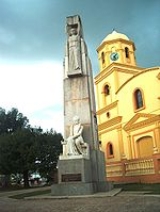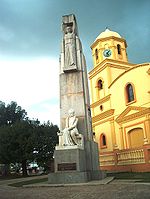
Salvador Brau
Encyclopedia
Dr. Salvador Brau Asencio , (January 11, 1842 – November 5, 1912) was a journalist
, poet and writer from Puerto Rico
. He was also a renowned historian
.
, also known as the town of Cofresí
, into a well-to-do family who taught him the importance of a good education. His father was Bartolomé Brau, a Catalan
teacher of German descent and his mother was Luisa Asencio, a native of Venezuela
. Brau received his primary and secondary education in private schools. After he graduated from high school, he decided to continue his education in an institute of higher learning.
In 1861, Brau went to Spain and attended the University of Barcelona where he earned a degree in Letters. During his stay in Spain, he came into contact with the autonomist movement of Puerto Rico and became involved. Eventually, Brau earned his Doctorate in Letters. Brau was not a historian in the sense that he earned a degree in that field. However, his interest in finding out about the early history of the island led him to become a self-taught historian.
 In 1870, Brau returned to Puerto Rico and became a journalist. Being a firm believer that Puerto Rico should be granted more powers by the Spanish Crown, he joined the Autonomist Party of Puerto Rico and became politically active. He also expressed his beliefs in his novels and plays. One of his most acclaimed plays is "La Vuelta al Hogar" (Once on This Island).
In 1870, Brau returned to Puerto Rico and became a journalist. Being a firm believer that Puerto Rico should be granted more powers by the Spanish Crown, he joined the Autonomist Party of Puerto Rico and became politically active. He also expressed his beliefs in his novels and plays. One of his most acclaimed plays is "La Vuelta al Hogar" (Once on This Island).
In 1894, Brau was named Commissioner for the Provincial Deputation. He then moved back to Spain where he was to carry out the task of investigating the historical documents pertaining to Puerto Rico's past. These documents were stored and continue to be stored in the Indias Archives of Seville. In 1897, after three years of investigating the historical documents, Brau returned to the island.
Some of his findings in Seville were documents written by Fray Antonio de Montesinos, Fray Iñigo Abbad and many others. He uncovered important information about how the Taínos lived and how they were treated harshly by the Spanish settlers. During his investigation he also found an interesting reference to the Puerto Rican danza
. According to a document written by Fray Iñgo Abad Lasierra, Bishop of Puerto Rico (1772–1778), there was a typical, fast and noisy shoe-stomping dance in the island which he called "Puerto Rican danza". Brau, however, claims that the authentic Puerto Rican danza was a popular creation that emerged in the 19th century.
. Brau continued to be politically active and on 1903 was named Official Historian of Puerto Rico by the U.S. appointed governor William Henry Hunt
. He held this position until his death.
. He was interred in Santa Maria Magdalena de Pazzis Cemetery
in Old San Juan.
The town of San Juan honored him with a park and a statue.
The town of Cabo Rojo has honored his memory with a monument and by naming a hall in its amfitheater after him. The town of Aguada
also has a bust of Brau in its plaza. He was also one of the few Puerto Ricans to be honored by the United States Maritime Commission when they named a World War II Liberty Ship after him, the SS Salvador Brau, USMC Hull Number 1543. The ship was built in 1944 and was eventually scraped in 1966.
Journalist
A journalist collects and distributes news and other information. A journalist's work is referred to as journalism.A reporter is a type of journalist who researchs, writes, and reports on information to be presented in mass media, including print media , electronic media , and digital media A...
, poet and writer from Puerto Rico
Puerto Rico
Puerto Rico , officially the Commonwealth of Puerto Rico , is an unincorporated territory of the United States, located in the northeastern Caribbean, east of the Dominican Republic and west of both the United States Virgin Islands and the British Virgin Islands.Puerto Rico comprises an...
. He was also a renowned historian
Historian
A historian is a person who studies and writes about the past and is regarded as an authority on it. Historians are concerned with the continuous, methodical narrative and research of past events as relating to the human race; as well as the study of all history in time. If the individual is...
.
Early years
Brau was born in Cabo Rojo, Puerto RicoCabo Rojo, Puerto Rico
Cabo Rojo is a municipality situated on the southwest coast of Puerto Rico and forms part of the San Germán–Cabo Rojo metropolitan area as well as the larger Mayagüez–San Germán–Cabo Rojo Combined Statistical Area....
, also known as the town of Cofresí
Roberto Cofresí
Roberto Cofresí , better known as "El Pirata Cofresí", was the most renowned pirate in Puerto Rico. He became interested in sailing at a young age. By the time he reached adulthood there were some political and economic difficulties in Puerto Rico, which at the time was a colony of Spain...
, into a well-to-do family who taught him the importance of a good education. His father was Bartolomé Brau, a Catalan
Catalan people
The Catalans or Catalonians are the people from, or with origins in, Catalonia that form a historical nationality in Spain. The inhabitants of the adjacent portion of southern France are sometimes included in this definition...
teacher of German descent and his mother was Luisa Asencio, a native of Venezuela
Venezuela
Venezuela , officially called the Bolivarian Republic of Venezuela , is a tropical country on the northern coast of South America. It borders Colombia to the west, Guyana to the east, and Brazil to the south...
. Brau received his primary and secondary education in private schools. After he graduated from high school, he decided to continue his education in an institute of higher learning.
In 1861, Brau went to Spain and attended the University of Barcelona where he earned a degree in Letters. During his stay in Spain, he came into contact with the autonomist movement of Puerto Rico and became involved. Eventually, Brau earned his Doctorate in Letters. Brau was not a historian in the sense that he earned a degree in that field. However, his interest in finding out about the early history of the island led him to become a self-taught historian.
Important discoveries

In 1894, Brau was named Commissioner for the Provincial Deputation. He then moved back to Spain where he was to carry out the task of investigating the historical documents pertaining to Puerto Rico's past. These documents were stored and continue to be stored in the Indias Archives of Seville. In 1897, after three years of investigating the historical documents, Brau returned to the island.
Some of his findings in Seville were documents written by Fray Antonio de Montesinos, Fray Iñigo Abbad and many others. He uncovered important information about how the Taínos lived and how they were treated harshly by the Spanish settlers. During his investigation he also found an interesting reference to the Puerto Rican danza
Music of Puerto Rico
The music of Puerto Rico has been influenced by the Spanish, African, Taíno Indians, France, and the United States, and has become very popular across the Caribbean and across the globe...
. According to a document written by Fray Iñgo Abad Lasierra, Bishop of Puerto Rico (1772–1778), there was a typical, fast and noisy shoe-stomping dance in the island which he called "Puerto Rican danza". Brau, however, claims that the authentic Puerto Rican danza was a popular creation that emerged in the 19th century.
Official Historian of Puerto Rico
In 1898, Puerto Rico became a territory of the United States after the Spanish American War in accordance with the Treaty of Paris (1898)Treaty of Paris (1898)
The Treaty of Paris of 1898 was signed on December 10, 1898, at the end of the Spanish-American War, and came into effect on April 11, 1899, when the ratifications were exchanged....
. Brau continued to be politically active and on 1903 was named Official Historian of Puerto Rico by the U.S. appointed governor William Henry Hunt
William Henry Hunt (judge)
William Henry Hunt was a state and federal judge and a territorial governor of Puerto Rico.-Early law practice:...
. He held this position until his death.
Written works
Among Braus written works are the following:- Puerto Rico and its History
- The History of Puerto Rico
- The Colonization of Puerto Rico
- The Founding of PoncePonce, Puerto RicoPonce is both a city and a municipality in the southern part of Puerto Rico. The city is the seat of the municipal government.The city of Ponce, the fourth most populated in Puerto Rico, and the most populated outside of the San Juan metropolitan area, is named for Juan Ponce de León y Loayza, the...
- ¿Pecadora? (a novel)
Legacy
On November 5, 1912, Salvador Brau died in San Juan, Puerto RicoSan Juan, Puerto Rico
San Juan , officially Municipio de la Ciudad Capital San Juan Bautista , is the capital and most populous municipality in Puerto Rico, an unincorporated territory of the United States. As of the 2010 census, it had a population of 395,326 making it the 46th-largest city under the jurisdiction of...
. He was interred in Santa Maria Magdalena de Pazzis Cemetery
Santa Maria Magdalena de Pazzis Cemetery
Santa María Magdalena de Pazzis Cemetery is a colonial-era cemetery located in Old San Juan, Puerto Rico. It is the final resting place of many of Puerto Rico's most prominent natives and residents. Construction began in 1863 under the auspices of Ignacio Mascaro. The cemetery is located outside...
in Old San Juan.
The town of San Juan honored him with a park and a statue.
The town of Cabo Rojo has honored his memory with a monument and by naming a hall in its amfitheater after him. The town of Aguada
Aguada, Puerto Rico
Aguada is a municipality of Puerto Rico, located in the western coastal valley region bordering the Atlantic Ocean, west of Rincón, Aguadilla and Moca; and north of Anasco. It is part of the Aguadilla-Isabela-San Sebastián Metropolitan Statistical Area...
also has a bust of Brau in its plaza. He was also one of the few Puerto Ricans to be honored by the United States Maritime Commission when they named a World War II Liberty Ship after him, the SS Salvador Brau, USMC Hull Number 1543. The ship was built in 1944 and was eventually scraped in 1966.
See also
- List of famous Puerto Ricans
- German immigration to Puerto RicoGerman immigration to Puerto RicoGerman immigration to Puerto Rico increased when German businessmen immigrated to Puerto Rico during the early part of the 19th century. However, it was the economic and political situation in Europe during the early 19th century plus, the fact that the Spanish Crown issued the Royal Decree of...
External links
- El Nuevo Dia
- Puerto Rico y su historia by Salvador Brau at Google Books.

